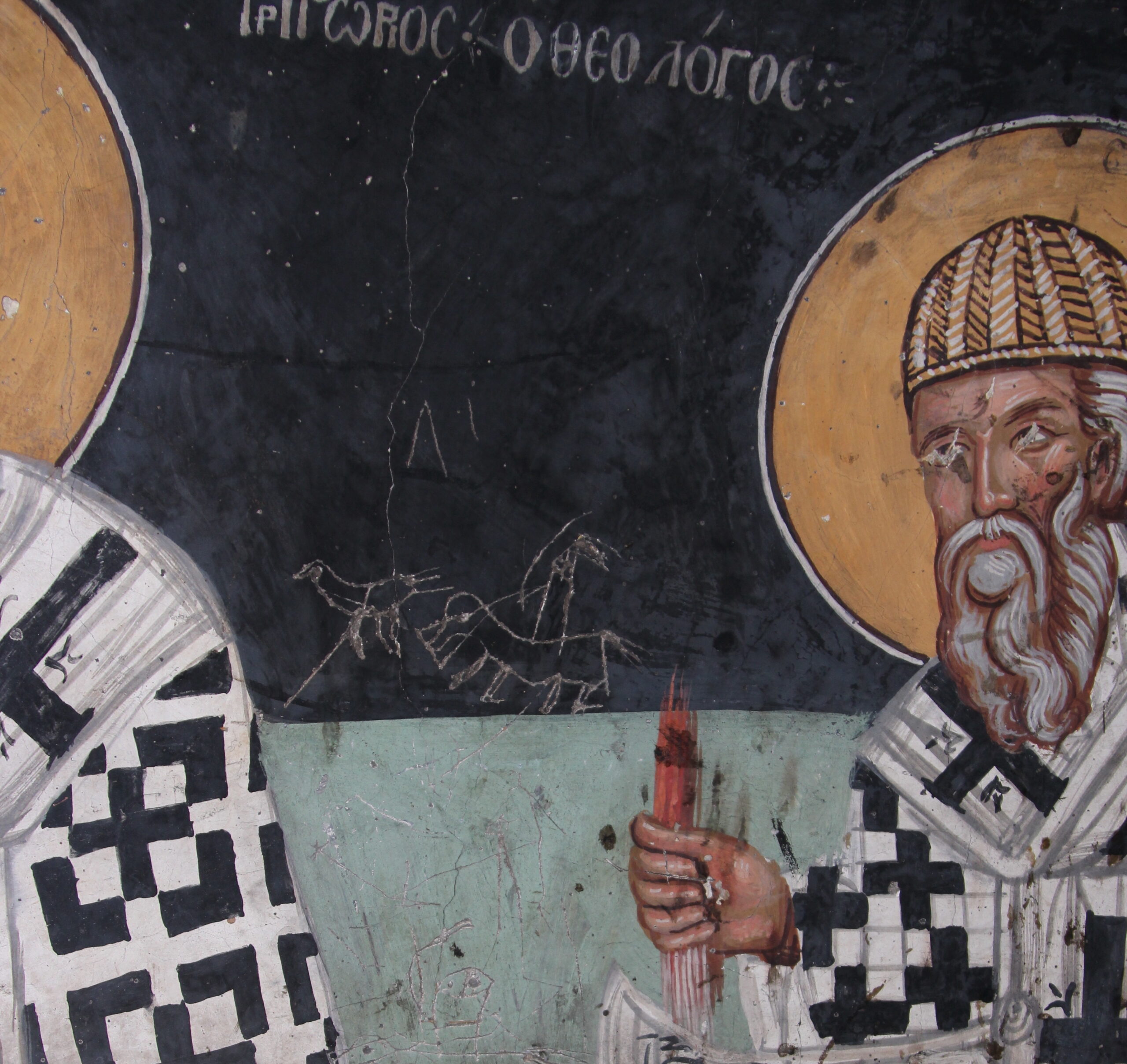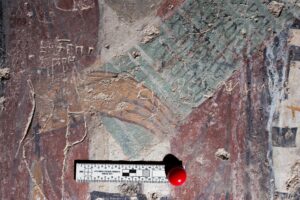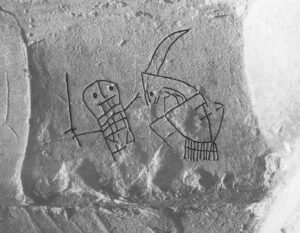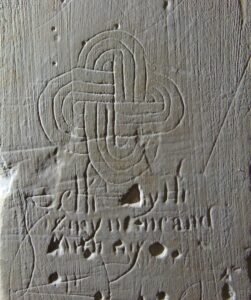
Graffiti of a knight fighting a dragon (Church in Galata, Cyprus). © Mia Trentin/The Cyprus Institute-STARC
Graffiti characterizes human history from its very beginning, and even if they may have changed in form and content throughout the centuries, it can be argued that they represent the fulfilment of two fundamental human needs: to communicate and to relate to the space in which they were created. The human need to leave something behind them. To make their mark on the world that they so briefly pass through.
Writing is one of the most efficient forms of communication since it creates messages that can be delivered even without the author’s presence. Writing delivers messages to the future. Scholars studying prehistory identify the act of writing as one of the first distinctive actions that characterize the evolution of human beings. Written expression, whether recognizable words or images, is one of the starting points of our evolution, and it was only possible thanks to our self-awareness, continuously achieved through the relations with our equals and with the spaces in which we lived.
Writing allows us to relate to space through a process of appropriation. Writing is leaving a tangible sign of my presence, a message. It is imposing and impresses someone’s presence into a specific space. Furthermore, writing relates that individual to others, even without their presence. As part of a broader society, people will have access to that message. This process, even if latent and unconscious, is present in the writer’s intentions. The fundamental human need to ‘make their mark’.
Graffiti transcends the barriers not only of time but of class, education, and social status. Graffiti can be made by everyone, on any surface and with makeshift tools, interacting with almost any space. Thanks to that, graffiti can offer insights into the everyday life of past societies from a wider perspective, reversing the conventional historical vision that tends to consider only the main historical events and processes, using conventional historical and literary sources. Graffiti can be made by Princes and peasants, saints and sinners alike.

Worshippers’ names in Latin, Greek and Armenian in Agia Solomoni in Paphos (Cyprus) © Mia Trentin/The Cyprus Institute-STARC
This visual evidence represents a unique resource which provides original insights into past societies. The study of graffiti recovers the lost voices of past people, their messages, hopes, fears, and ideas – adding and integrating our traditional historical and socio-cultural knowledge with a lively and wholly new perspective. It allows us to populate buildings, natural and anthropic spaces through the tangible evidence of people living and experiencing those places. Graffiti really does have the potential to bring the past to life.
Thanks to its privileged geographical position – already in the East but representing the last western land – Cyprus has always been, and still is, a crucial point in the eastern sea routes of the Mediterranean. It was the last stop for ships going to Syria, Lebanon and Egypt and the first on their way back. The local community is the result of the vivid political and economic history of the island and included Greeks, Latins, Maronites, Armenians and Arabs. They shared the urban and rural landscape of the island, and its natural and anthropic spaces. Traces of their passage and interactions are preserved in the graffiti they left behind.
Mostly present in religious buildings – churches and mosques – Cypriot graffiti preserves a unique written archive composed of inscriptions in four alphabets (Greek, Latin, Armenian and Arabic) and a rich variety of drawings, including figurative motives as well as symbols.
Since 2017 the APACLabs team (https://apaclabs.cyi.ac.cy ) at The Cyprus Institute-STARC has study the Medieval and Early Modern graffiti of the island, contributing to shedding light on this graphic heritage, starting tracing patterns of interaction and communication of past people with their surrounding space (https://dioptra.cyi.ac.cy/?q=grafmedia; https://www.facebook.com/cy.graffiti). Thus, the tangible graffiti heritage becomes a key source for exploring an intangible one, linked to everyday practices and habits of common people not usually recorded by other sources. Creating graffiti was tolerated, even inside buildings with a public function. Moreover, it was perceived as an individual act of interaction with the sacred, fulfilling different needs: to commemorate, to worship, and to protect. Despite the collective dimension of the practice attested by their distribution, the diverse graffiti typologies and people involved, graffiti is essentially an individual act, one of those private, widespread and well-known practices that people do not feel the need to mention in more common and traditional sources.
Studying and documenting this material offers a significant contribution to our limited knowledge of these unknown aspects of the past, such as religious practices, magic, and superstition. The intangible dimension revealed by graffiti enriches our understanding of historical monuments with new elements, such as their active relationship with people through their messages, prayers and hopes, their fears and exorcisms.
Graffiti helps to integrate the social and historical value of historic buildings and landscapes, recovering the voices of people who lived and experienced those places in the past. On the other hand, considering the more material and formal aspects of graffiti, it can be observed that writing – in a broad sense – was widely practised even in rural areas about which there is often no other written evidence. The writing that emerges from graffiti is a functional one, focusing on its most essential characteristics: recording information and self-affirmation.
The formal variety present in graffiti – alphabetic and pictorial – reflects the expressive and communicative richness of people from different social strata and different origins who shared the same spaces. The presence of graffiti in four different alphabets and the variety of shapes and motifs of pictorial graffiti reflect the multicultural character of the island and the ability of people to interact and communicate with multimodal solutions.

 © Knight fighting a dragon (All Saints church in Marsham, UK). Matthew Champion, The Norfolk Medieval Graffiti Survey
© Knight fighting a dragon (All Saints church in Marsham, UK). Matthew Champion, The Norfolk Medieval Graffiti Survey
Nearly two thousand miles away, on another island on the other side of Europe, a similar project has been undertaken to record and interpret the medieval graffiti inscriptions found in churches in the United Kingdom. The Norfolk & Suffolk Medieval Graffiti Survey (www.medieval-graffiti.uk.uk) was established in 2009 to undertake the very first large-scale and systematic survey of surviving historical inscriptions in English medieval churches. The project was an entirely volunteer-led citizen science undertaking that saw hundreds of volunteers record tens of thousands of previously unknown graffiti inscriptions.
What has been most enlightening about the two projects is that, despite being at opposite ends of Europe, the medieval graffiti inscriptions being recorded showed remarkable similarities. Whilst the multiple languages recorded on Cyprus were replaced with just English and Latin in the UK, it was amongst the pictorial graffiti that identical motifs and symbols were recorded. It was also clear that many of these images were clearly devotional in nature, again echoing the findings of the work undertaken in Cyprus. The popularity of the UK projects has also had considerable benefits for the churches being studied, where the graffiti inscriptions have aided in the public interpretation of the buildings and been a significant draw to tourists.
What the projects in the UK and Cyprus have shown is that the study of historical graffiti in all its forms has begun to shed new light on the way in which we view the people of the past and the world in which they inhabited. Another language is emerging. A medieval pan-European language of symbols and motifs which were perpetuated over time. The study of graffiti collects these ‘alphabets’ of letters, symbols, and shapes in an attempt to recover their meaning and give voice to the collection of messages, hopes, and prayers still preserved in the historical monuments of these two islands. Perhaps more importantly, and like the graffiti itself, these messages scrawled on a medieval church wall are open to all.
Matthew Champion, The Norfolk Medieval Graffiti Survey
Mia Gaia Trentin, The Cyprus Institute-STARC





Follow us: